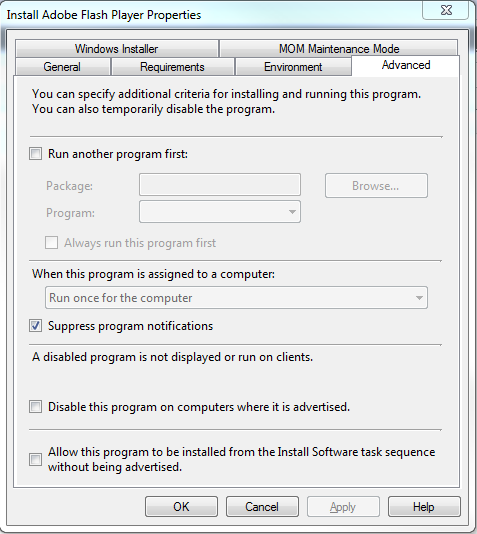In this post, I’ll go through the process to deploy and update Adobe Flash using System Center Configuration Manager 2007 R2 (SCCM) and a simple batch file.
If you don’t have a license to distribute Adobe Flash, apply for one here http://www.adobe.com/products/players/flash-player-distribution.html. It’s a simple process and gives you access to the offline msi installations of Adobe Flash.
Once you have your software distribution license for Adobe Flash, download the msi installer for the latest version of Flash and store it on a share. Ensure all users have read access to this share as the installation will run from here.
In the same share create a batch file. In this example I’ve called the batch file InstallAdobeFlash.cmd. Create another text file in the same location called mms.cfg. This file will be used to disable automatic Adobe Flash updates. Your share should look something like this.
Edit mms.cfg and add the following two lines to disable auto updates:
AutoUpdateDisable=1
SilentAutoUpdateEnable=0
The Adobe Flash msi updates any existing installations, so the deployment and update process is simple. Edit InstallAdobeFlash.cmd and add the lines below, updating the share path for your environment. The batch file silently updates Adobe Flash to the latest version and copies the mms.cfg file to the appropriate location depending upon whether the computer is 32, or 64 bit.
If Not Exist %WINDIR%\SysWow64\Macromed\Flash GoTo 32Bit
:64Bit
msiexec /i \\ServerShare\SoftwareDistribution\Packages\Adobe_Flash\install_flash_player_11_active_x.msi /qn
copy \\ServerShare\SoftwareDistribution\Packages\Adobe_Flash\mms.cfg %WINDIR%\SysWow64\Macromed\Flash /y
:32Bit
msiexec /i \\ServerShare\SoftwareDistribution\Packages\Adobe_Flash\install_flash_player_11_active_x.msi /qn
copy \\ServerShare\SoftwareDistribution\Packages\Adobe_Flash\mms.cfg %WINDIR%\System32\Macromed\Flash /y
Now setup a standard software package in SCCM to run the batch file. On the program properties, choose to run Hidden and take no action after running. From the Environment tab ensure the program can run Whether or not a user is logged on and Run with administrative rights. I also Suppress program notifications on the Advanced tab.
In order to update Adobe Flash when a new version is released, download the latest msi. Copy it to the installation share, overwriting the previous version’s msi. I then enable the advertisement to re-run every time and re-run the advertisement to deploy the latest update. To do this, right-click on the advertisement and choose properties, go to the schedule tab, change Program rerun behavior to “Always rerun program”. Click Ok, then right-click on the advertisement and choose Re-run Advertisement.












